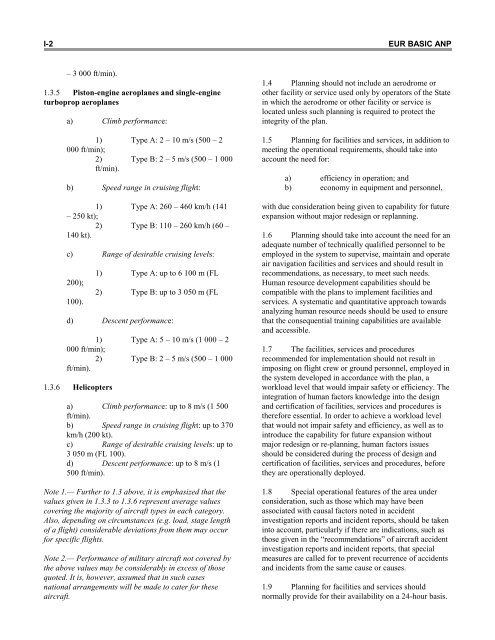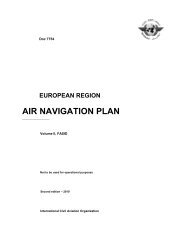7754 Vol 1 Flyleaf - ICAO Public Maps
7754 Vol 1 Flyleaf - ICAO Public Maps
7754 Vol 1 Flyleaf - ICAO Public Maps
Create successful ePaper yourself
Turn your PDF publications into a flip-book with our unique Google optimized e-Paper software.
I-2 EUR BASIC ANP<br />
– 3 000 ft/min).<br />
1.3.5 Piston-engine aeroplanes and single-engine<br />
turboprop aeroplanes<br />
a) Climb performance:<br />
1) Type A: 2 – 10 m/s (500 – 2<br />
000 ft/min);<br />
2) Type B: 2 – 5 m/s (500 – 1 000<br />
ft/min).<br />
b) Speed range in cruising flight:<br />
1) Type A: 260 – 460 km/h (141<br />
– 250 kt);<br />
2) Type B: 110 – 260 km/h (60 –<br />
140 kt).<br />
c) Range of desirable cruising levels:<br />
200);<br />
100).<br />
1) Type A: up to 6 100 m (FL<br />
2) Type B: up to 3 050 m (FL<br />
d) Descent performance:<br />
1) Type A: 5 – 10 m/s (1 000 – 2<br />
000 ft/min);<br />
2) Type B: 2 – 5 m/s (500 – 1 000<br />
ft/min).<br />
1.3.6 Helicopters<br />
a) Climb performance: up to 8 m/s (1 500<br />
ft/min).<br />
b) Speed range in cruising flight: up to 370<br />
km/h (200 kt).<br />
c) Range of desirable cruising levels: up to<br />
3 050 m (FL 100).<br />
d) Descent performance: up to 8 m/s (1<br />
500 ft/min).<br />
Note 1.— Further to 1.3 above, it is emphasized that the<br />
values given in 1.3.3 to 1.3.6 represent average values<br />
covering the majority of aircraft types in each category.<br />
Also, depending on circumstances (e.g. load, stage length<br />
of a flight) considerable deviations from them may occur<br />
for specific flights.<br />
Note 2.— Performance of military aircraft not covered by<br />
the above values may be considerably in excess of those<br />
quoted. It is, however, assumed that in such cases<br />
national arrangements will be made to cater for these<br />
aircraft.<br />
1.4 Planning should not include an aerodrome or<br />
other facility or service used only by operators of the State<br />
in which the aerodrome or other facility or service is<br />
located unless such planning is required to protect the<br />
integrity of the plan.<br />
1.5 Planning for facilities and services, in addition to<br />
meeting the operational requirements, should take into<br />
account the need for:<br />
a) efficiency in operation; and<br />
b) economy in equipment and personnel,<br />
with due consideration being given to capability for future<br />
expansion without major redesign or replanning.<br />
1.6 Planning should take into account the need for an<br />
adequate number of technically qualified personnel to be<br />
employed in the system to supervise, maintain and operate<br />
air navigation facilities and services and should result in<br />
recommendations, as necessary, to meet such needs.<br />
Human resource development capabilities should be<br />
compatible with the plans to implement facilities and<br />
services. A systematic and quantitative approach towards<br />
analyzing human resource needs should be used to ensure<br />
that the consequential training capabilities are available<br />
and accessible.<br />
1.7 The facilities, services and procedures<br />
recommended for implementation should not result in<br />
imposing on flight crew or ground personnel, employed in<br />
the system developed in accordance with the plan, a<br />
workload level that would impair safety or efficiency. The<br />
integration of human factors knowledge into the design<br />
and certification of facilities, services and procedures is<br />
therefore essential. In order to achieve a workload level<br />
that would not impair safety and efficiency, as well as to<br />
introduce the capability for future expansion without<br />
major redesign or re-planning, human factors issues<br />
should be considered during the process of design and<br />
certification of facilities, services and procedures, before<br />
they are operationally deployed.<br />
1.8 Special operational features of the area under<br />
consideration, such as those which may have been<br />
associated with causal factors noted in accident<br />
investigation reports and incident reports, should be taken<br />
into account, particularly if there are indications, such as<br />
those given in the ―recommendations‖ of aircraft accident<br />
investigation reports and incident reports, that special<br />
measures are called for to prevent recurrence of accidents<br />
and incidents from the same cause or causes.<br />
1.9 Planning for facilities and services should<br />
normally provide for their availability on a 24-hour basis.














